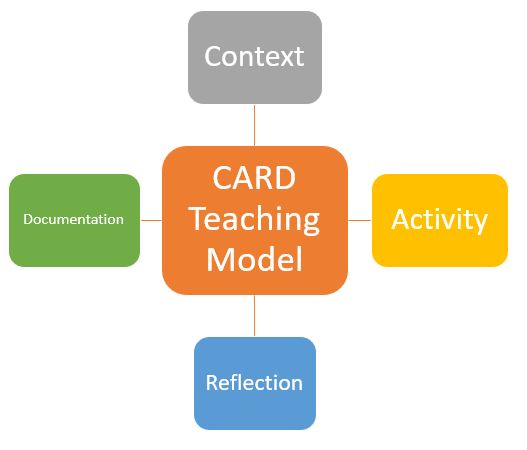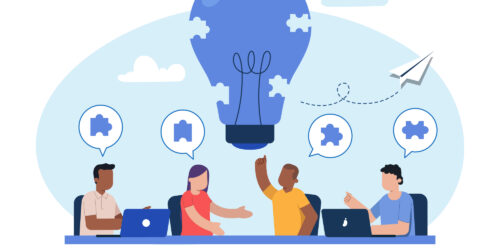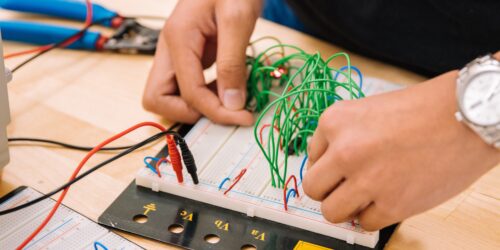Creating a CARD Lesson Plan
Lesson plans provide structure, flow, and focus to a class meeting. This teaching tip provides information on the CARD lesson plan. The CARD lesson plan can be used in any mode of delivery. The CARD lesson plan is also known as the CARL lesson plan.
BOPPPS or CARD
While a BOPPPS lesson plan structures a lesson using interactive practice following a presentation, the CARD lesson plan provides opportunities for reflection and learning following a hands-on activity or experience. See more information below, then download the online synchronous CARD lesson plan template to get started.
Understanding the CARD Method
There are 4 main parts of the CARD method of lesson planning.
Context
The faculty member introduces the lesson by providing the context within the course, program, industry, or current events.
The faculty member also describes the expressive outcomes for the lesson (rather than learning objectives or outcomes, as in the BOPPPS model) (UBC, 2020). Expressive outcomes are not pre-determined; rather, they are generated out of a reflective response to an activity (Eisner, 1972). Expressive outcomes are more open-ended; they predict and describe areas of growth and learning rather than pre-determine and limit them (Stout, 1990).
The faculty member then introduces the activity or experience. The steps of the activity are given, along with any cautionaries, including what could make people feel vulnerable. The faculty should provide or discuss ground rules that make the activity a safe space to engage, and alternative ways to participate if students do not feel safe.
Questions to prepare for the context portion of the lesson plan include:
- What is the context of the lesson?
- What is the context of the activity?
- Who is here participating in the activity?
- What are we hoping to accomplish (expressive outcomes)?
- How are we going to accomplish it?
- What could make students feel vulnerable or unsafe, and what can be done to ensure students feel safe?
Activity
The activity component of the CARD lesson is some form of active or experiential learning. It may a problem, a physical activity like drawing, a role play, a case study, a scenario, a demonstration with participation, a simulation, etc. During the activity time, learners might be asked, for example, to brainstorm, listen, persuade, act, demonstrate, discuss, list, compare, question, and draw.
Activity instructions should be brief but clear. Learners should not be asked to engage in activities beyond their abilities. The faculty member monitors time as well as participant safety and comfort. The activity should take only a proportional amount of class time to allow for reflection and documentation.
Reflection
Participants may be asked to reflect individually, in a small group, in a big group, or in a combination. The role of the faculty member is to facilitate and guide discussion, providing observations or additional information only as examples or to get the discussion going.
The reflection has three parts:
Observation – In first part of the reflection, learners are asked to state what they observed during the activity, relying only on what they saw and felt.
Questions to prepare for observation reflections
- What did I do?
- What did I feel or think?
- What did I observe others doing?
- What else happened?
Interpretation – In second part of the reflection, learners are asked to make sense of what they observed. They may use deduction, explication, and other thought processes to understand the meaning behind their observations and the observations they hear from others.
Questions to prepare for interpretation reflections:
- Why did I choose this action?
- Why did others choose their actions?
- What other actions could I/they have chosen?
- What else can we understand?
Conclusion – In the last part of the reflection, learners draw conclusions based on comparing, contrasting, and combining interpretations to emerge with an evaluation or judgements about their learning.
Questions to prepare for conclusion reflections:
- What do we conclude from this reflection?
- Why does it matter?
- What do we know that we didn’t know before?
- How does what we know change how we will think, feel, and act in the future?
- How does what we know apply to the course?
Documentation (of Learning)
In the Documentation of Learning stage, the lesson concludes with learners completing some form of writing or recording activity in which they make note of what they learned from the activity and reflection. The documentation may be composed individually or collaboratively, and responses may be shared for review at a further date.
Tips and Innovations
Download the CARD Template
Use this downloadable template to organize and describe the lesson plan. Make notes on how the lesson went on the lesson plan directly after the lesson for future modifications
Practice Giving Activity Instructions
Ensure that activity instructions are clear, succinct, and sufficient to complete the activity without stopping it. Give sufficient context and ask for informed consent–Do not hide information from students that may make them feel uncomfortable.
Manage or Stop the Activity if Necessary
If the activity is not proceeding as intended and puts participants at risk, plan to adapt the activity, or stop it entirely. If only a pause is necessary for clarification, remind the participants of the original instructions and then continue the activity.
Avoid “Leading” Reflection
Facilitators may should guide the discussion, but should avoid interjecting personal opinion or agendas into the reflection. Be alert to group dynamics and encourage challenging reflections while maintaining a climate of respect and safety within the group. Model an open-minded attitude, respectful communication practices, and democratic dialogue among group members reflecting together.
Manage Situations
Avoid a few people dominating discussion by indicating that you want input from everyone. Have learners reflect in small groups if they feel uncomfortable sharing in the large group. Share a digital or print copy of the reflection questions to keep discussion focused. Acknowledge feelings, but pre-empt or respond to personal attacks during reflection with a break.
Review Documentation
It may be useful to collect the documentation to review learners’ takeaways. If the learners have lost focus, it may be beneficial to review reflections during the next class.
References
Eisner, E. (1972). Emerging models for educational evaluation. American Journal of Education 80(4). https://www.journals.uchicago.edu/doi/abs/10.1086/443050 https://doi.org/10.1086/443050
Reed, J., & Kolba, Ch. (n.d.). Facilitating reflection: A manual for leaders and educators. https://www.uvm.edu/~dewey/reflection_manual/facilitating.html
Stout, C.J. (1990). Emphasis on expressive outcomes in teaching art appreciation. Art Education, 43(5), 57-69, DOI: 10.1080/00043125.1990.11654297
The University of Edinburgh (2020). The CARL framework of reflection. https://www.ed.ac.uk/reflection/reflectors-toolkit/reflecting-on-experience/carl
UBC Wiki (2018). Documentation: ISW/Lesson Plan/Theme Session/Classroom Challenges https://wiki.ubc.ca/Documentation:ISW/Lesson_Plan/Theme_Session/Classroom_Challenges




